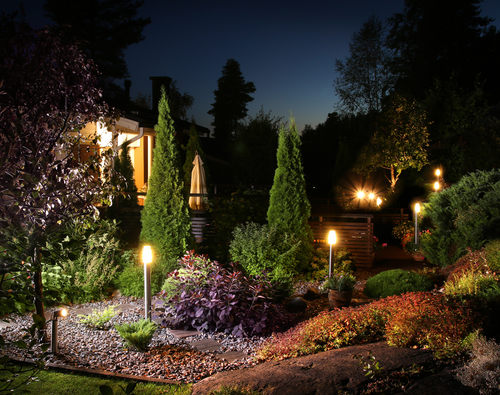The best outdoor lighting designs provide more than just visibility, also adding aesthetic appeal to both the yard and house. Tour your property at night with a strong flashlight to see what could use better illumination. You can install outdoor lighting in many places, for multiple purposes:
- House floodlights: Spotlight the home at night with lighting mounted to the facade or placed a few feet away.
- Security lighting: Add motion sensors for the driveway, sidewalk, and doorways, as well as timer lights or dawn-to-dusk area lighting to deter intruders.
- Tree lighting: Uplight a tree for dramatic effect or mount lighting in a tree for ambient lighting below.
- Pathway lights: Illuminate walkways and welcome guests with in-ground lights, lamp posts, etc.
- Accent lights: Enjoy your architectural features, water fountains, and landscaping for better curb appeal day and night.
- Pool lighting: Light the perimeter of a pool for safety, add mood lighting around hot tubs and seating areas, and illuminate pool equipment when needed.
How to Add Outdoor Wiring

Burying wires for outdoor lights can be a very straightforward task. As long as you have properly rated outdoor wiring that works with your preferred fixtures, it’s mostly a matter of digging, burying, and covering with dirt.
Most people need to bring in a licensed electrician for the two hardest parts of the job:
- Low-voltage transformers: Outdoor lighting uses lower voltage than what runs in your home. Low-voltage, 12V wiring is safe in wet conditions, easier to install than line voltage, and ideal for outdoor lighting fixtures. The transformers mount on GFCI outlets for safe outdoor power.
- Outdoor light fixture installation: For fixtures that are not plug-and-go, the installation process can involve piercing or splicing wires. Follow safety protocols if you do this yourself, or ask an electrical contractor to complete the job.
Are Solar Landscape Lights a Good Idea?
Free energy and wireless installation make outdoor solar lighting a very attractive option. Just don’t rely on solar for security lighting or important task lighting.
Technology has improved, but you still don’t want your light source to be at the whims of mother nature. In the North Bay area, we get strings of cloudy days often enough that your solar landscape lights won’t always be able to churn out much illumination.
Consider solar lights a great choice for supplemental light around the yard or along pathways.
Outdoor Lighting Shadows and Dark Spots
Exterior lighting works much like indoor lighting; you need a mix of task lighting and ambient lighting. If you only install floodlights and path lights, you’ll wind up with awkward shadows. For security lighting, shadows can actually make your home less safe—you don’t want to create dark areas where burglars can hide.
Some options for outdoor ambient lighting include recessed lights over a porch, downlighting from trees, and multi-directional lights like lanterns and lamp posts.
Warm lights with low lumens around the yard can make the entire outdoor area look and feel more comfortable while you’re out there, and your home will be safer and more attractive.
Put It Down on Paper
Once you know how many fixtures you need and which types, you can move forward with the wiring and installation of outdoor lighting. Working with a lighting professional can help ensure you purchase the right kind and quantity of light fixtures as well as the correct wires and transformers to power it all.
Looking to add outdoor lighting? Santa Rosa homeowners and businesses can request an on-site consultation from Spyrka Electric for outdoor lighting wiring and installation.

